With the growing and constant popularity of SaaS products, more businesses eagerly use such technologies and actively implement them in their working environment for a myriad of reasons. Understanding SaaS benefits and the ways to develop it is impossible without a proper understanding of the technology itself. Essentially, SaaS is a technology available through browsers and on any device with an Internet connection, but as with any other technology, there are many nuances.
It usually starts with in-depth research, followed by UI/UX design, MVP development to quickly test the idea, QA processes, deployment, and post-release monitoring. However, all those steps tend to grow big while including numerous aspects.
Thus, this article will cover what is SaaS and how to develop a SaaS product from the idea seed to a successful product. So, you are about to find out what SaaS technology is, how to build a SaaS application, and why it is important for running and developing businesses.
SaaS product definition
SaaS, or software as a service, stands for a cloud computing model. It is provided over the Internet on a subscription basis, allowing you to use it on the web without installing it. This means that a customer can access the software needed and all its functionality on any device with a web browser and an Internet connection.
Modern SaaS technology is realized in a huge variety of products, many of which we use daily. Google Docs is perhaps the best-known example. It is a web-based software office suite within Google Drive service. Among other most prominent examples of SaaS providers are the following market leaders:
- Salesforce;
- Oracle;
- Amazon;
- Google;
- IBM;
- Slack;
- Microsoft;
- HubSpot;
- Shopify;
- Figma.
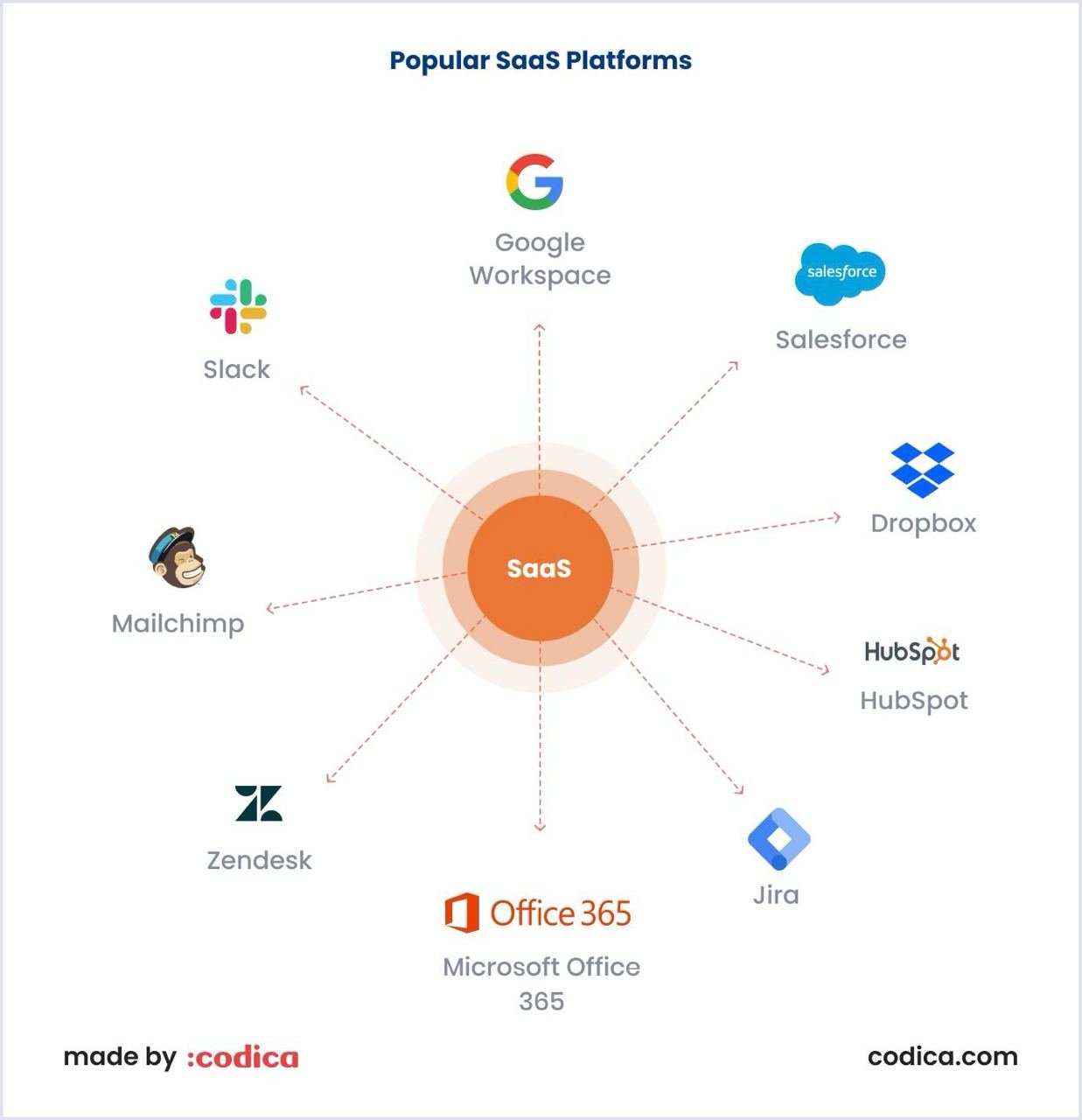
Although all these products are SaaS, they are built differently. Thus, to understand the SaaS development world better, let’s shift focus to the types of SaaS products.
What is a SaaS business model?
SaaS business model is a software delivery method where software is licensed on a subscription basis and centrally hosted by a third-party provider. This business model generates revenue by providing software solutions to single or enterprise-level users.
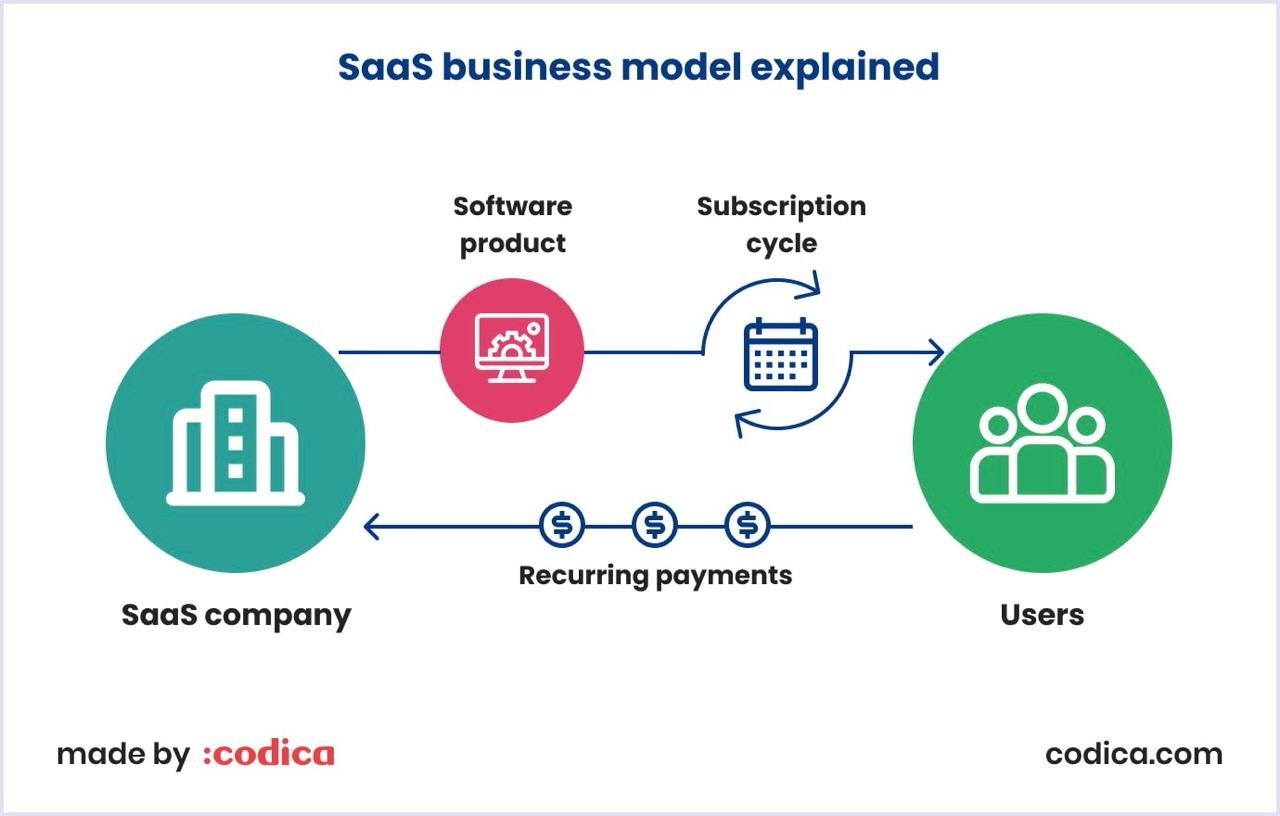
For more understanding, SaaS product always aims to be the key to solving specific problems. For instance, Zoom and Slack eliminate the remote work disadvantages by providing convenient messaging and video meeting features.
Notably, these products are cloud-based. Thus, they rely on cloud computing to offer rich functionality and store the data somewhere. In return, users don’t have to download anything as the product usually works on the web.
Thus, the business model choice for your startup is a crucial step. With a SaaS business model, there is no need to spend on expensive infrastructure, which reduces the cost of services and, accordingly, the subscription price.
Types of SaaS products
To begin with, there are two main types of SaaS, with vertical and horizontal focus. Thus, each of them is the backbone of any SaaS product. In this regard, vertical SaaS is characterized as more specialized software used in narrow niches. Horizontal, on the other hand, covers a wider area, delivering content or products to a wider audience. Here’s a detailed comparison.
| Characteristic | Vertical SaaS | Horizontal SaaS |
| Scope | Narrow, focused on a specific industry or niche | Broad, applicable across various industries and business functions |
| Flexibility | More specialized, less flexible outside the targeted industry | More flexible and adaptable across different business environments |
| Applicability | Ideal for businesses within a specific industry seeking tailored solutions | Suitable for businesses with general needs across various sectors |
| Industry focus | Industry-specific, addressing unique challenges and requirements | Generalized, providing solutions for common business processes |
| Customization | Deeper level of customization for the targeted industry | Offers flexibility but may not provide as deep customization within a specific industry |
| Examples | Healthcare SaaS, financial services SaaS, legal SaaS | CRM software, ERP software, accounting software |
| Functionality | Specialized features for industry-specific processes | Generalized features applicable to a wide range of business functions |
| Scalability | May be limited in scalability outside the targeted industry | Scalable across businesses of different sizes and industries |
As you can see from the outline of horizontal and vertical SaaS, they are quite different. Hence, products built with a focus on one of the two have different purposes, functionality, and applicability.
Both horizontal and vertical SaaS approaches are involved in many different products. For this reason, let’s take a look at several practical implementations of them.
Read also: Horizontal vs Vertical Marketplace: Examples & Benefits of Each Type
Vertical SaaS applications
The vertical approach in SaaS implies tailoring the product for specific industries or niches, addressing their unique needs and requirements.
| Name | Description | Examples |
| Healthcare software | Tailored solutions for managing healthcare-related processes, such as patient records and medical billing. | Zocdoc, Cerner, Helsi |
| Financial services software | Specialized tools for financial institutions, including banking, investment, and accounting software. | Stripe, Salesforce |
| Legal software | Solutions designed for law firms and legal professionals to manage cases, documents, and legal processes. | Everlaw, Onit, Clio |
| Retail software | Addresses the unique needs of retail businesses, covering inventory management, point of sale, and customer engagement. | 24TTL, Wholesale, Toolio |
| Manufacturing software | Streamlines processes in manufacturing, including production planning, supply chain management, and quality control. | Autodesk, Synopsis |
| Education software | Supports educational institutions with tools for e-learning, student management, and administration. | Coursera, Duolingo, Skillsoft |
Horizontal SaaS applications
SaaS apps with a horizontal focus are designed for broad use across various industries and business functions. Here are several examples.
| Name | Description | Examples |
| CRM software | Manages interactions with customers, streamlines sales processes, and improves customer service. | Salesforce, HubSpot, Zoho CRM |
| ERP software | Integrates core business processes like finance, human resources, inventory management, and procurement into a unified system. | SAP, Oracle NetSuite, Microsoft Dynamics 365 |
| Accounting software | Automates financial processes, including invoicing, budgeting, and expense tracking. | QuickBooks Online, Xero, FreshBooks |
| HR software | Assists in managing HR functions such as recruitment, employee onboarding, performance management, and payroll. | Workday, BambooHR, ADP |
| Project management software | Helps teams plan, collaborate, and track project progress. | Asana, Trello, Jira |
| Email marketing software | Facilitates the creation and management of email marketing campaigns. | Mailchimp, Constant Contact, SendinBlue |
| Content management systems (CMS) | Assists in creating, managing, and publishing digital content. | WordPress, Wix, Squarespace |
| Ecommerce platforms | Enable businesses to set up and manage online stores. | Shopify, BigCommerce, Magento |
| Communication tools | Facilitate collaboration and communication among team members. | Slack, Microsoft Teams, Zoom |
The SaaS market continues to evolve, with new applications satisfying emerging needs and industries. The categories mentioned above provide a foundational understanding of the diverse types of SaaS products available today.
SaaS pricing models
Choosing a suitable pricing model is paramount for providers and users. Each approach brings its advantages and considerations, satisfying diverse business needs. There are the following SaaS pricing models:
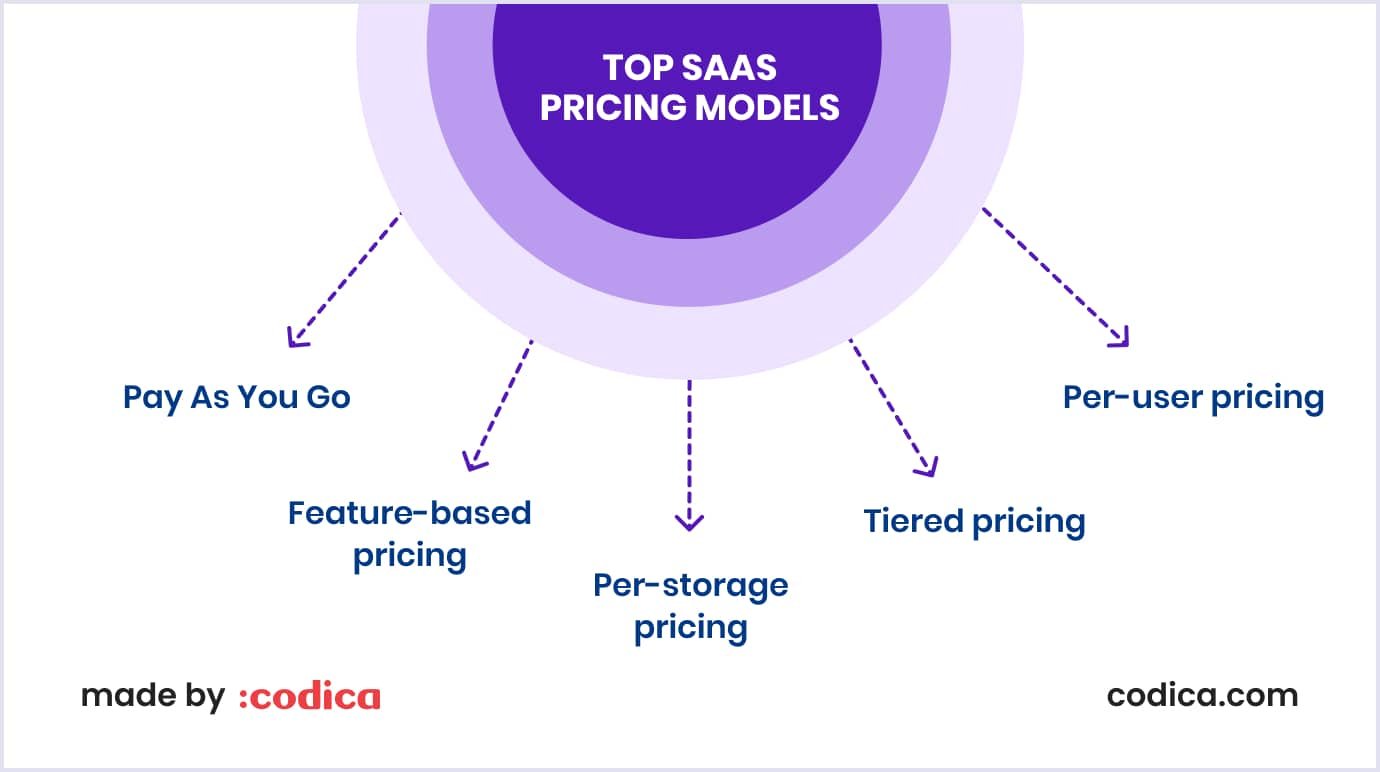
- Per-user pricing. This pricing model aligns costs with usage, offering a scalable solution for businesses of all sizes. As companies grow, they can easily manage expenses by paying only for the required licenses. This model encourages efficiency, making it an ideal choice for enterprises with fluctuating user numbers.
- Tiered pricing. This approach allows users to select a strategy that aligns with their requirements, providing flexibility and scalability. As businesses evolve, they can seamlessly transition to higher tiers, unlocking additional features and capabilities.
- Per-storage pricing. This model benefits businesses dealing with inconsistent data volumes, enabling them to optimize costs based on their storage needs. It's a particularly advantageous choice for data-centric SaaS solutions.
- Feature-based pricing. Within various pricing models for SaaS software, this approach revolves around the functionalities offered by the software. Users pay based on their required features, promoting a customized, cost-effective approach.
- Pay As You Go. This real-time billing structure ensures cost efficiency, especially for applications with unpredictable usage patterns. It allows businesses to scale up or down based on demand, making it an agile and financially prudent option.
As the SaaS landscape evolves, selecting a suitable pricing model is a strategic decision that profoundly impacts providers and users. By understanding the sophistication of SaaS pricing, businesses can align their software investment with their unique requirements
Read also: Mobile App Monetization: Comprehensive Guide with Successful Strategies
Benefits of SaaS development
In general, SaaS development offers many advantages that streamline operations and enhance overall efficiency. The benefits of SaaS industry are redefining the way companies approach SaaS solutions. So, let's delve into some essential SaaS advantages.

- No setup needed. With SaaS development, there is no vast installation process. Users can access the software directly through a web browser, eliminating the need for complex setups and reducing the time and resources required to get started.
- On-demand scaling. SaaS solutions allow seamless scalability to accommodate varying workloads. Businesses can effortlessly scale up or down based on their requirements, ensuring optimal performance during peak times and cost savings during periods of lower demand.
- Flexible payment model. The SaaS industry offers a flexible payment model, typically based on subscription. This allows organizations to choose plans that align with their needs and budget constraints. The pay-as-you-go model also allows adding or reducing services as business requirements evolve.
- Access anytime, from any device, anywhere. One of the critical advantages of SaaS development is the accessibility it provides. Users can log in and use the software with an Internet connection from any device. This level of flexibility promotes remote work and collaboration across locations and ensures that teams can stay productive regardless of their physical location.
- Quick upgrades. Software as a service application often comes with automatic updates, ensuring that users can access the latest features and security patches without manual intervention. This quick upgrade cycle keeps the software relevant, reduces the burden on IT teams, and enhances the overall user experience (UX).
In fact, this is just a general overview of the SaaS development advantages. We have a thorough article on the benefits of SaaS, which will help you choose this development niche.
SaaS industry trends
In software as a service development, a few significant changes are happening that are improving things for businesses. Let's break it down into simple SaaS industry trends.
Multi-cloud strategy
According to the survey, 90% of mid to large enterprises use a multi-cloud solution. Small companies rarely adopt multi-cloud solutions due to tight budgets.
Now, companies are not sticking to just one cloud provider. They are spreading their digital work across different clouds. This helps them stay strong even if one cloud has issues. Also, it lets them choose the best features from various providers, making their IT systems more flexible.
Artificial intelligence
So, artificial intelligence (AI) is like the brainpower behind the scenes. It is making SaaS tools brighter. With AI, these tools can read data better, automate tasks, and forecastthings. This helps businesses make intelligent decisions and work more efficiently.
A noteworthy example of effective AI integration is evident in Salesforce. This SaaS platform monitors customer interactions, assisting businesses in enhancing their services. The application facilitates necessary modifications based on the insights gathered from the accumulated data.

Low code/no code cloud services
Building computer applications used to be a job for experts. Now, with low code and no code cloud services, anyone can create and modify apps without needing to be a coding pro. This makes things faster and lets people in the business have a hand in making valuable applications.
These platforms provide users with ready-made templates and user-friendly drag-and-drop interfaces, eliminating the necessity for intricate coding. It is foreseeable that many companies will embrace them to enhance the efficiency of their software development workflows. As a result, this will foster heightened adaptability in the face of evolving market dynamics.
By the way, you may have heard about other trends in SaaS, such as micro-SaaS, unbundling, white labeling, blockchain, and more. It is also essential to research these SaaS trends thoroughly to understand this topic. This will help you choose new ways for your business and make your SaaS product customer-friendly.
How to build a SaaS startup
First, what is a SaaS startup? A SaaS startup is like a digital toolbox for businesses. It could be anything from project management software to tools for customer support. In a nutshell, a SaaS startup is all about delivering useful software services to businesses over the Internet.
Now, let’s discover the main steps of SaaS startup development.
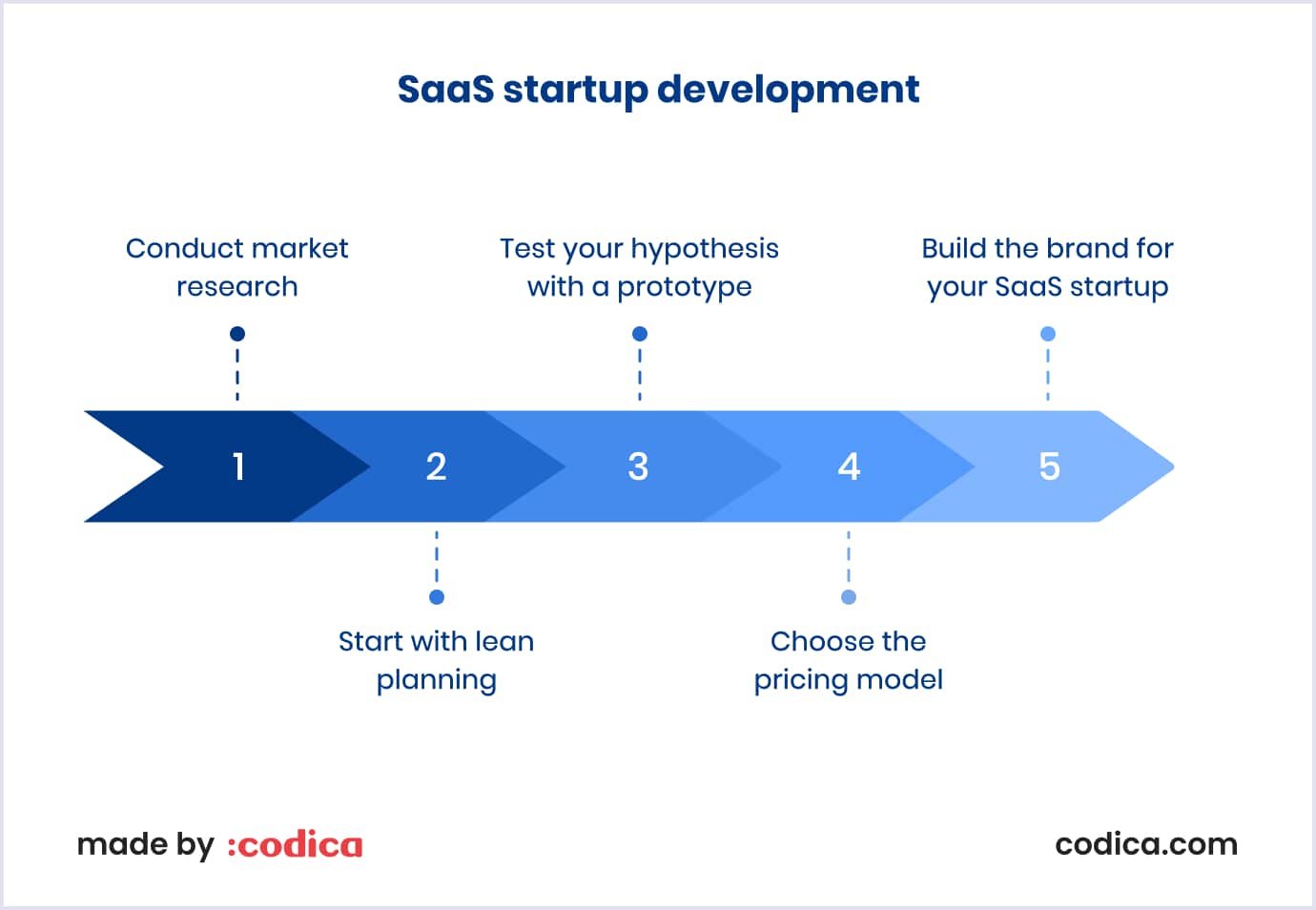
1. Conduct market research
Launching on market research is an essential initial step when laying the foundation for a SaaS company. What key elements should be included in this market research? We focus on pivotal aspects such as an industry overview, target market research, and competition analysis. Let's check these components in more detail.
- Industry overview: it is essential to enhance your industry knowledge by identifying your market segment dimensions and staying updated on current SaaS startups trends. Key trends include a shift towards vertical markets, the increasing popularity of mobile-first SaaS apps, and transitions from SaaS to PaaS. To stay informed, participate in trade shows, summits, and webinars for valuable insights that can keep your SaaS product competitive.
- Target market research: avoid the mistake of trying to satisfy everyone with your SaaS products, as it can be time-consuming and resource-intensive. Instead, focus on identifying your potential customers and understanding how to reach them effectively. Gather detailed information about your target audience (age, gender, location, education, and occupation). This data will enable more precise targeting and ultimately contribute to the success of your SaaS startup.
- Competition analysis: examine your competitors to understand their cloud computing model (SaaS, PaaS, or IaaS) and analyze their product features, update frequency, and financial information. Analyze pricing models, revenue, annual reports, and promotional strategies to identify their strengths and weaknesses. This knowledge will give you a strategic advantage in the market.
2. Start with lean planning
When planning, you can follow one of the two ways: write a traditional business plan or save your time by making up a lean business plan.
The most important points that should be covered when starting a SaaS business:
- Problems your SaaS product solves;
- Target audience;
- Competitors;
- SaaS hosting provider;
- Sales channels and marketing strategies;
- Revenue sources;
- Milestones;
- Partners and resources.
Below, you can see a vivid example of a lean plan for a startup offered by Tom Morkes.
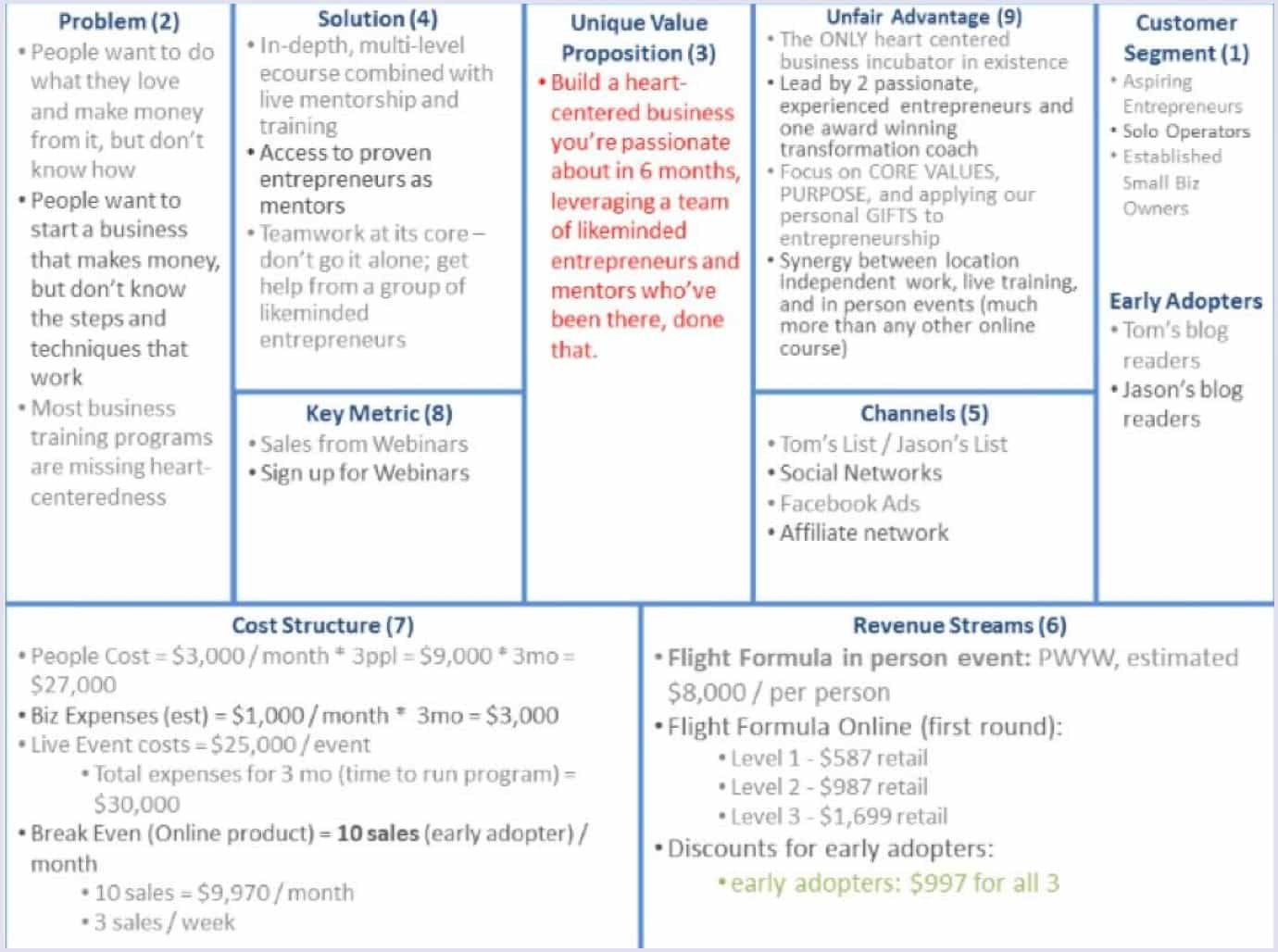
3. Test your hypothesis with a prototype
After assessing the market potential of your SaaS business idea and identifying high demand, it is advisable to begin with a prototype rather than immediately building a fully-fledged application. In a nutshell, a prototype is an incomplete version that serves as a draft, providing a tangible representation of your idea for potential investors. It simplifies communication compared to technical specifications and is crucial for testing.
Early adopters and investors help test the prototype, allowing you to understand user interactions and gather feedback for adjustments. This approach, common in software consultancies, facilitates a more informed and iterative product development process.
At Codica, our team developed the mobile app prototype for a multi-vendor marketplace for buying and selling cars in Africa.

4. Choose the pricing model
The success of any business, including a SaaS startup or online marketplace, hinges on choosing a suitable revenue model. This model, whether for pricing in SaaS or monetization in online marketplaces, determines how the venture will generate profits.
To ensure a stable income, it's crucial to carefully select and possibly combine different revenue models to mitigate financial risks. For example, it is about free applications, ads supported, flat-rate pricing, freemium, per-storage pricing, and more.
By the way, we will analyze pricing models in more detail later in the article.
Read also: 10 Best Marketplace Monetization Strategies to Succeed
5. Build the brand for your SaaS startup
How can you differ from the rivals? Building a solid brand is equally essential. Develop a compelling brand identity that resonates with your target audience. This includes a distinctive logo, a clear value proposition, and consistent messaging.
A strong brand attracts customers and builds trust and credibility in the competitive SaaS landscape. To achieve these points:
- Define your brand's mission, philosophy, and objectives;
- Prioritize the quality of your services;
- Work on robust naming, conveying the idea and mission of your brand.
In summary, building a SaaS startup involves a systematic approach where each step contributes to the foundation of a resilient and successful SaaS product.
Why SaaS startups fail
Have you ever wondered why most startup SaaS companies fail? There are the top five common reasons:
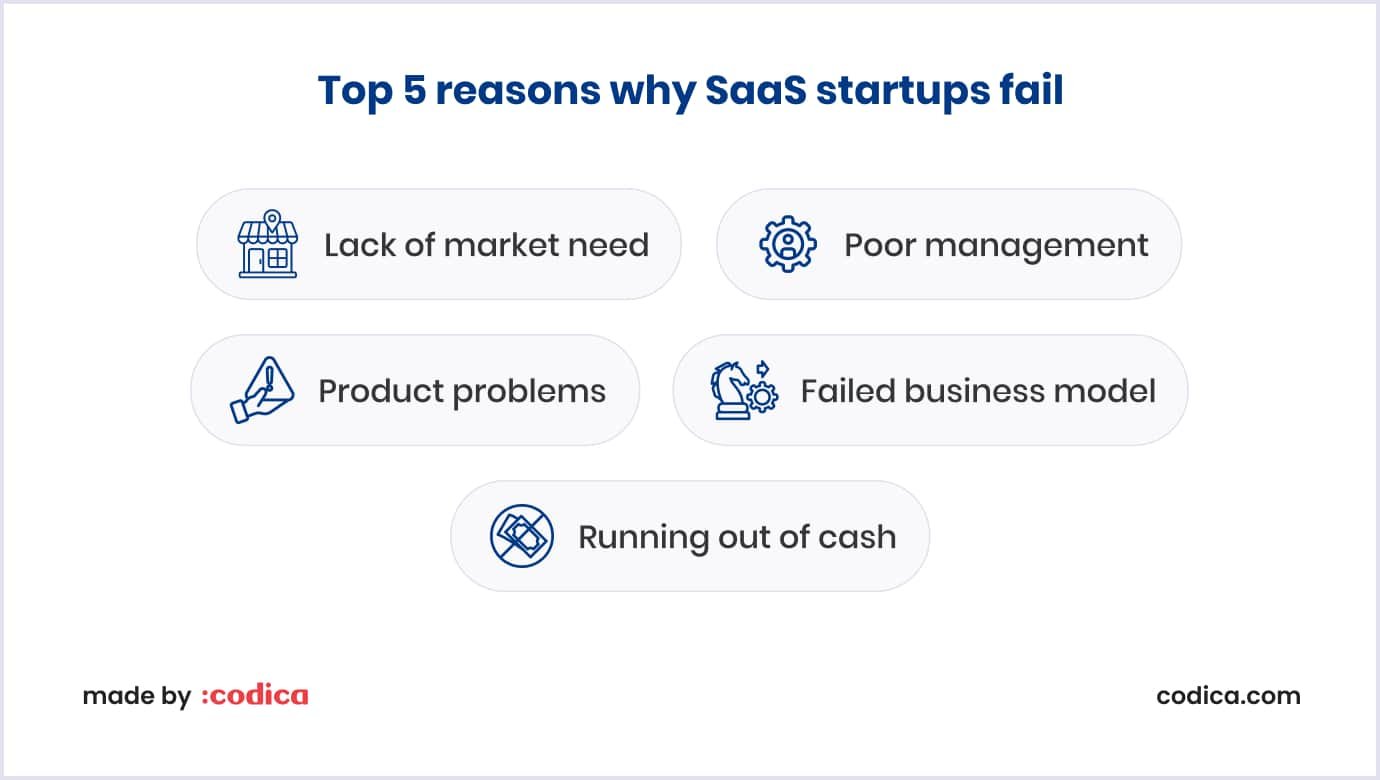
Lack of market need
A big mistake is creating a product without knowing if people want it. SaaS startups need to understand what customers need by talking to them. The startup is in trouble if there is no real demand for the product.
To confirm the existence of a market for your SaaS startup's product, it is advisable to introduce an initial basic solution. Utilizing minimum viable product services can prevent unnecessary resource wastage. However, it is essential to avoid excessively depending on your early adopters simultaneously.
Running out of cash
In the startup world, money is crucial. If a startup spends too much or doesn't plan its finances well, it can run out of money. Moreover, this financial vulnerability is exacerbated when there is no acceptable product-market fit. This means it won't have enough to keep going. Startups need to be wise about spending and plan for the long run.
Moreover, it is vital to follow next tips to prevent a SaaS startup failure:
- Don't underestimate the churn rate;
- Plan extra funds for your product improvement;
- Don't overestimate your future revenue.
For example, LucidEra is a famous example of a SaaS business that couldn't turn this process well and closed for this reason.

Poor management
A SaaS startup's success or failure hinges significantly on its leadership capabilities. Poor management decisions, lack of strategic foresight, and the inability to adapt to evolving circumstances can be detrimental.
Effective leadership involves guiding the company through stormy seas and fostering a cohesive and motivated team. On the other hand, weak leadership can create a wave effect, spreading through the entire organization and threatening the startup's chances of survival.
Failed business model
The SaaS business model must be resilient and adaptable. So, it is essential to continuously reassess and refine the revenue streams, pricing strategies, and value propositions. Ignoring shifts in the competitive landscape or technological advancements can render a once-promising business model outdated, leading to stagnation and eventual failure.
It is great to rely on the two critical metrics for SaaS startups in your project modeling. They are the following:
LTV (customer lifetime value)
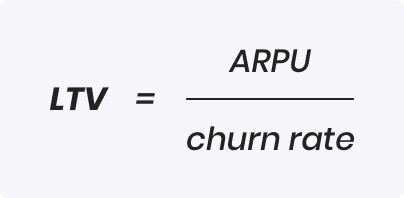
CAC (customer acquisition cost)

Product problems
A robust and user-friendly product is at the heart of every successful SaaS startup. Continuous innovation, agility in responding to user feedback, and a commitment to delivering exceptional user experiences are paramount. Ignoring these aspects can lead to a gradual deterioration of customer trust and satisfaction, ultimately resulting in the startup's expiration.
To ensure the success of your SaaS startup, focus on building a well-designed service, particularly if you have an innovative product idea. Be wary of competitors who may capitalize on your novelty, offering more intuitive solutions. It is crucial to fine-tune onboarding and support processes, address bugs promptly, provide excellent client support, and maintain transparent billing to boost customer loyalty and solidify your market position.
Moreover, regular communication with clients through surveys, phone calls, and interviews helps identify product flaws early, preventing potential business failure and ensuring you meet customer expectations.
For instance, Atrium is just a SaaS tech startup that closed due to a failure in the realization of a product idea.

To sum it up, SaaS startups need to be careful about what people need, manage their money wisely, have exemplary leaders, ensure their solid business plan, and keep their products in good shape. Learning from the mistakes of others can help them not just avoid failure but thrive in the challenging world of SaaS startups.
Best SaaS startups in 2024
We have already answered the question "What is a SaaS startup?" above. Now, let's move on to analyzing exciting SaaS startups 2024 in various domains.
Virtually

Virtually, a US-based SaaS startup, offers a comprehensive online learning platform with student management tools, robust chatting options, and simplified payment processing. It is fully customizable, allowing users to personalize branding, choose custom domains, and select personal color schemes. Virtually accommodates various online programs, from live classes to training camps, making it an inclusive and ideal SaaS solution for contemporary online schools.
Skio

Skio is among the fastest growing SaaS companies 2024, specializing in simplifying subscription management for brands. This subscription app enhances online store efficiency by improving customer inquiries handling, increasing sales, and elevating average order amounts. Users benefit from easy customization and bulk management of subscriptions, with key features including integration with various sources, SMS communication, subscription splitting, password-free login, and the utilization of webhooks.
Seedata.io

Established in 2021, Seedata.io stands out as a cloud-native cybersecurity platform, using cutting-edge technologies like custom enterprise software. As one of the successful SaaS startups, it specializes in analyzing clients' web solutions, employing AI tools to detect invisible threats. This proactive service helps enterprises mitigate the risk of data leakage and prevent cyber-attacks. Seedata.io has attracted significant seed investments, showcasing the success and potential of its rapidly growing SaaS products.
Copy.ai

Copy.ai, a leading cloud-based startup, simplifies the time-consuming process of copywriting. Positioned among the top SaaS companies 2024, it focuses on aiding customers in swiftly generating written business content. This AI-powered creativity tool excels in producing blog post drafts based on minimal input or preparing slogans for companies. Digital companies, copywriters, and ecommerce brands benefit from increased productivity and time savings by utilizing this innovative SaaS solution.
Hyperhuman

Hyperhuman, a thriving SaaS startup in the fitness sector, is experiencing rapid growth. This web platform facilitates the quick creation of high-quality video workouts for instructors, trainers, and coaches without needing advanced video editing skills. Users upload exercise videos using the company's mobile app, and Hyperhuman automatically edits them into reusable clips. The app also allows users to add audio instructions, and the resulting workout videos can be easily published on social media or other platforms.
Of course, this is only part of the examples list. Our specialists prepared a detailed article about successful SaaS startups in 2024, from small businesses to healthcare, environmental sustainability to education, and more.

SaaS application ideas
Within different technologies, SaaS offers innovative solutions to everyday challenges. Let's explore unique niche SaaS ideas.
Micro-SaaS
The concept of micro-SaaS involves creating smaller versions ("micro") of existing software as a service products. Micro-SaaS is affordable and scalable, focusing on specific niches or problems in a crowded market. It emphasizes saving time and money for users by offering a more streamlined solution.
Linkody, a micro-SaaS business that provides a website backlink tracker, illustrates how such experiences can meet specific customer needs and generate revenue.
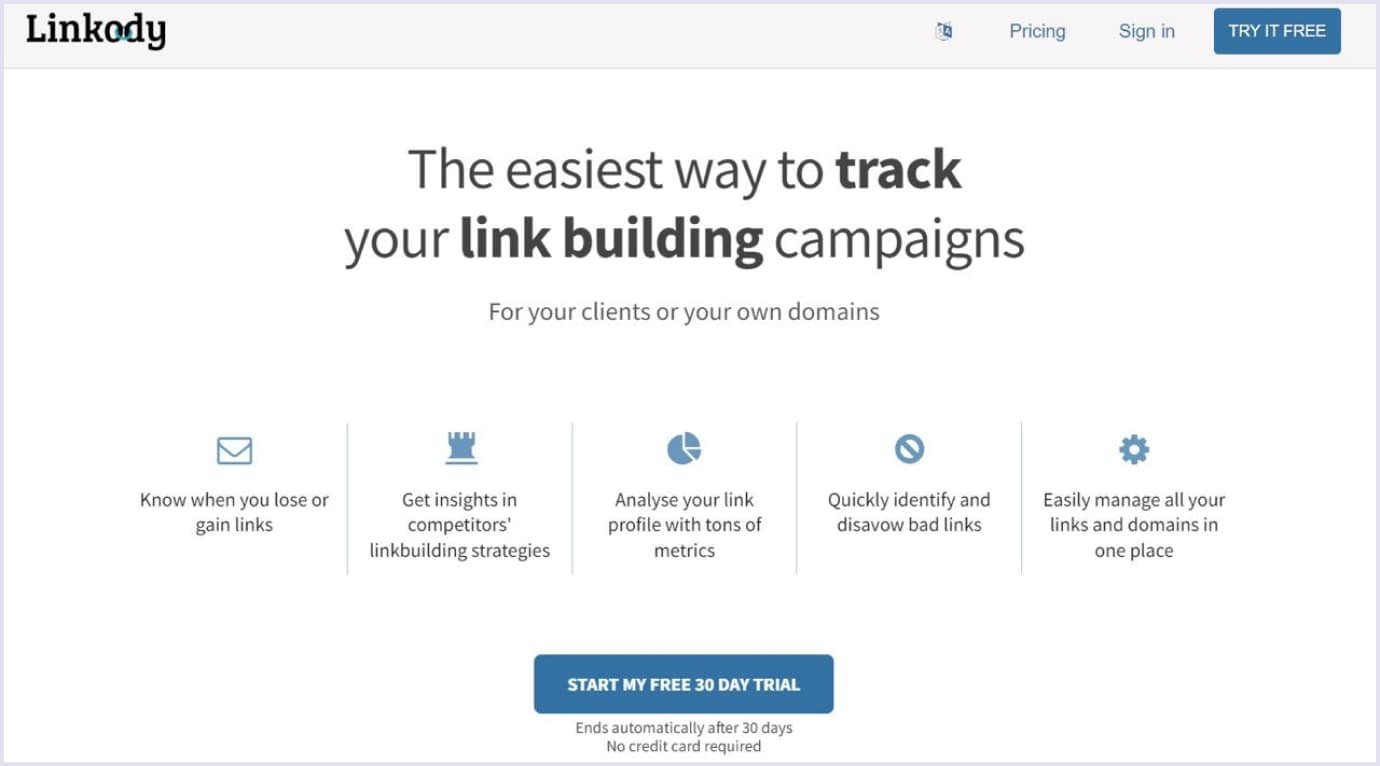
E-learning and training
Nowadays, there is a need for advanced e-learning solutions in the digital era. A comprehensive SaaS platform incorporating interactive content, personalized learning paths, and real-time assessments could revolutionize education. The platform aims to accommodate diverse learning styles, providing an immersive and engaging experience for educators and learners.
For example, EduConnect, a prominent SaaS e-learning platform, is cited as an example, showcasing a 30% improvement in student engagement and a 20% increase in learning outcomes through its AI-driven modules and personalized learning paths.
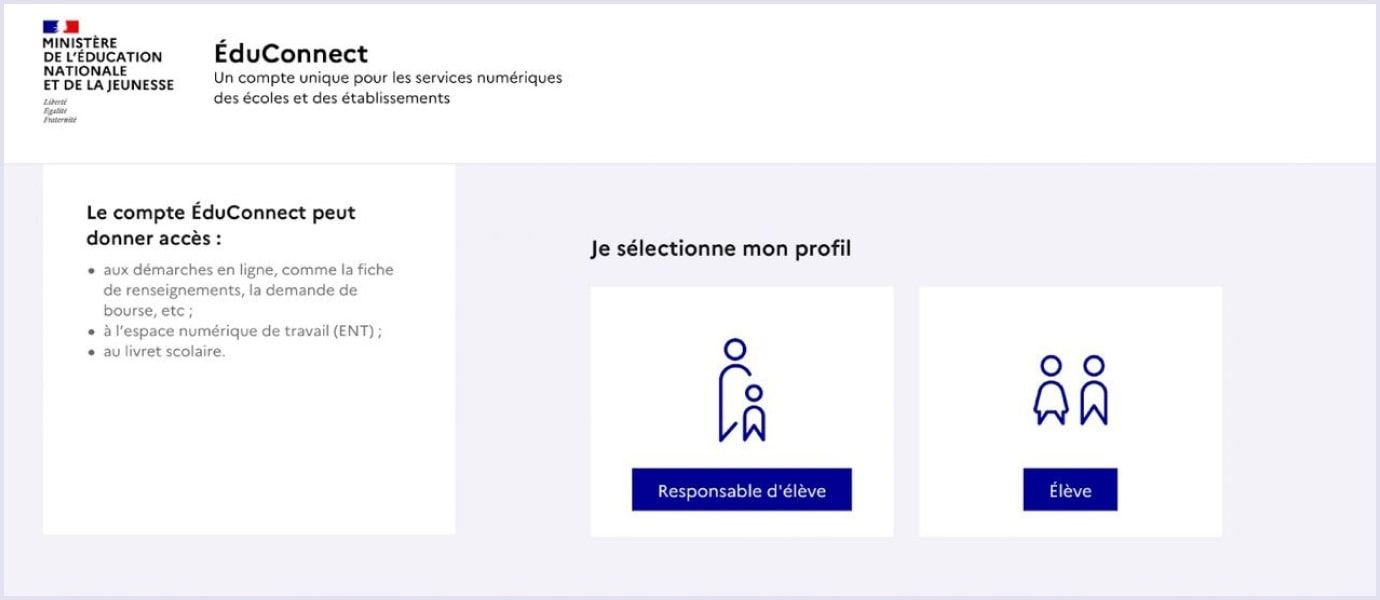
NFT marketplaces
In fact, creating an NFT (non-fungible tokens) marketplace platform is one of the best SaaS website ideas for 2024. NFTs represent unique digital items, including paintings, photos, videos, music, and gifs. Developing an NFT SaaS-based marketplace is seen as a way to support artists and foster technological innovation.
OpenSea, the world's largest NFT marketplace, is highlighted with over 121 million monthly users and a valuation of over $13.3 billion, having raised $427 million in venture capital since January 2022. The platform offers various categories, including sports, art, and projects from well-known artists, and allows users to buy NFTs in multiple formats, such as 3D objects, audio, or domain names.
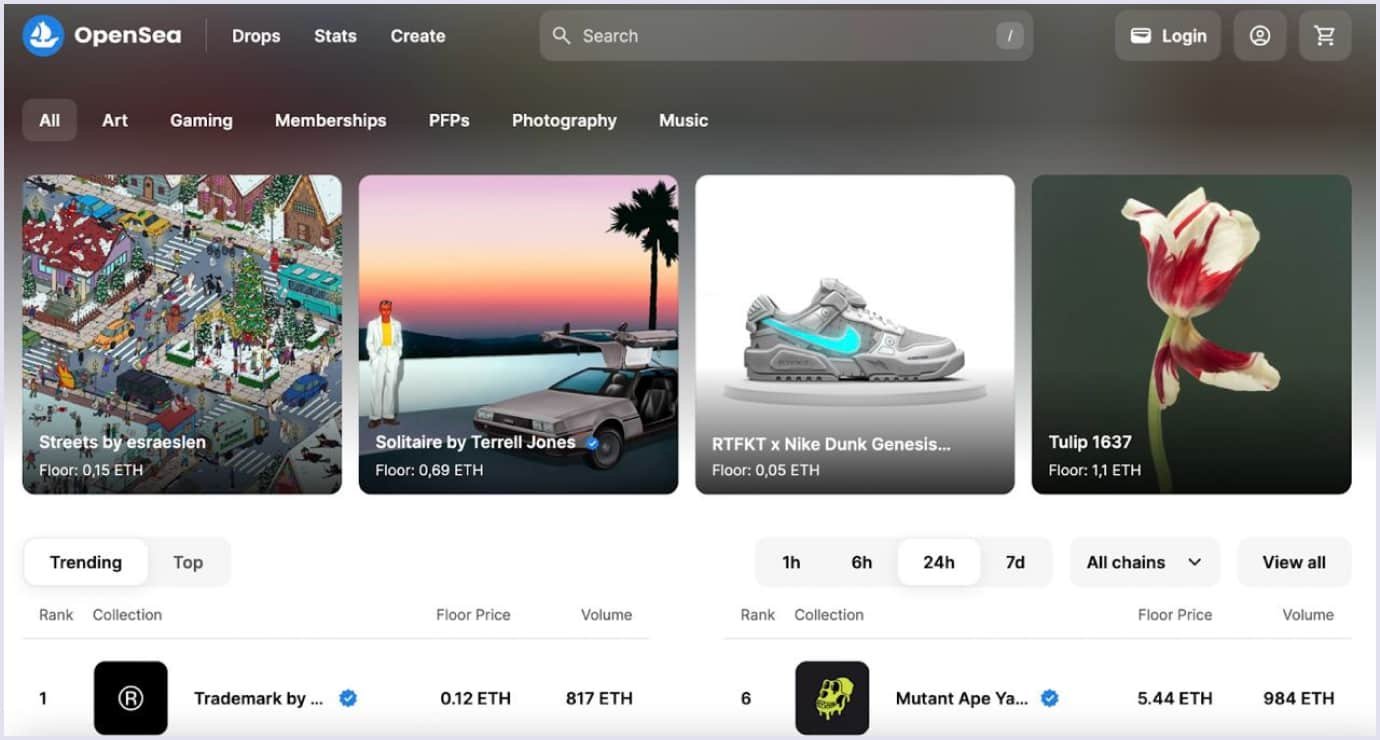
Investing tools
On the other hand, there is also potential for profitable SaaS business ideas in the investment field, particularly in applications that assist investors in determining whether a company's current valuation is favorable for acquisition. Stock market valuation applications are highlighted, enabling the prediction of growth rates, risk-free rates, and dividends. The accumulated experience recorded in these applications facilitates analysis for traders and investors to improve future trades.
Investing.com is a leading investment platform with a SaaS business model, offering real-time data, charts, stocks, forex, indices, currency quotes, technical analysis, financial news, and analytics to assist investors.

Social media management
It is essential to highlight the significant role of social media in people's daily lives, constituting 15% of waking time in 2023. So, social media posts offer a cost-efficient way for SaaS businesses to promote themselves. Social media management software is recommended for SaaS startups to streamline workflow, schedule posts, measure ROI (return on investment), run ads, and provide convenient reports.
Hootsuite allows users to efficiently manage multiple social media accounts, schedule posts, and analyze performance metrics, facilitating successful navigation in the dynamic world of social media for SaaS startups.
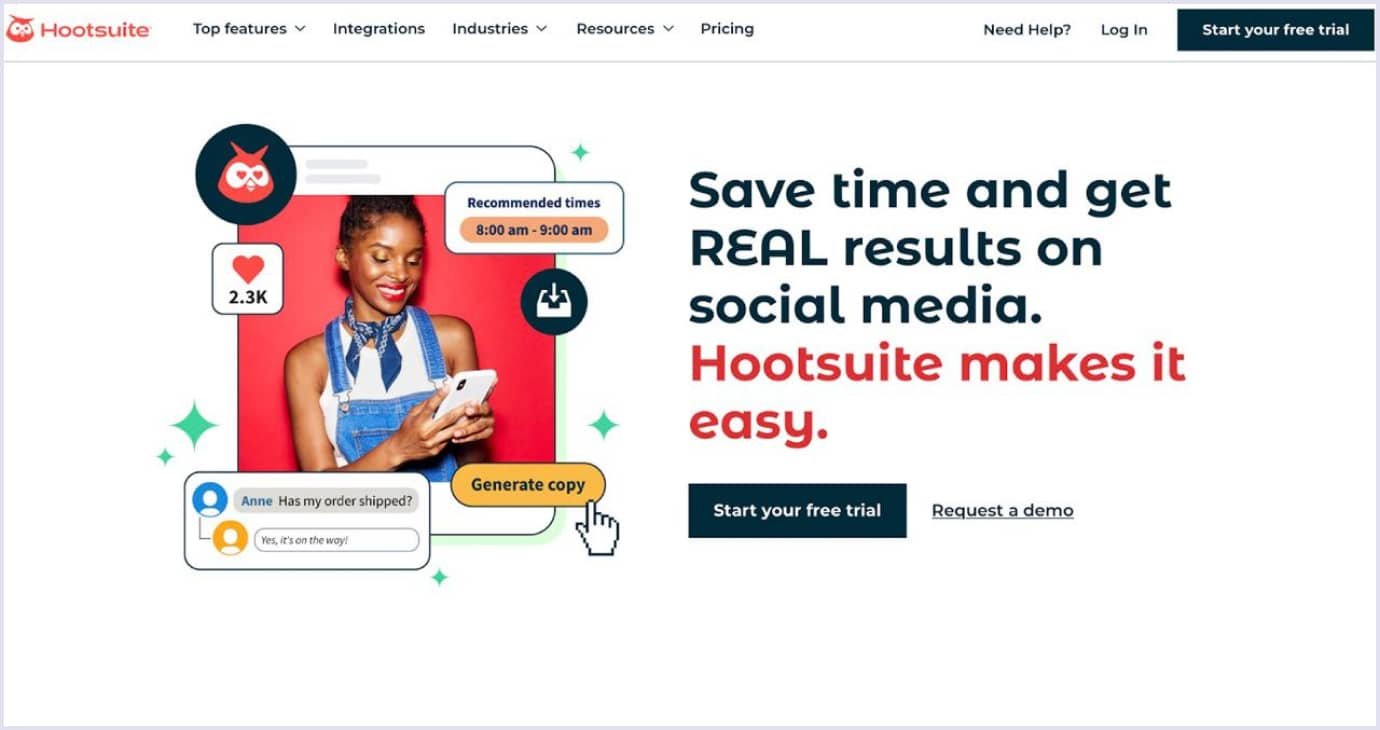
Remember, these SaaS ideas are just starting points for you to find inspiration. The key is identifying a unique angle or feature that sets your SaaS application apart in the market. To compare more SaaS products ideas, you can view our other detailed article.
Difference between IaaS vs PaaS vs SaaS
The main difference between IaaS, PaaS, and SaaS is critical in shaping the digital landscape. Each model represents a different element of cloud services, satisfying diverse needs and preferences.
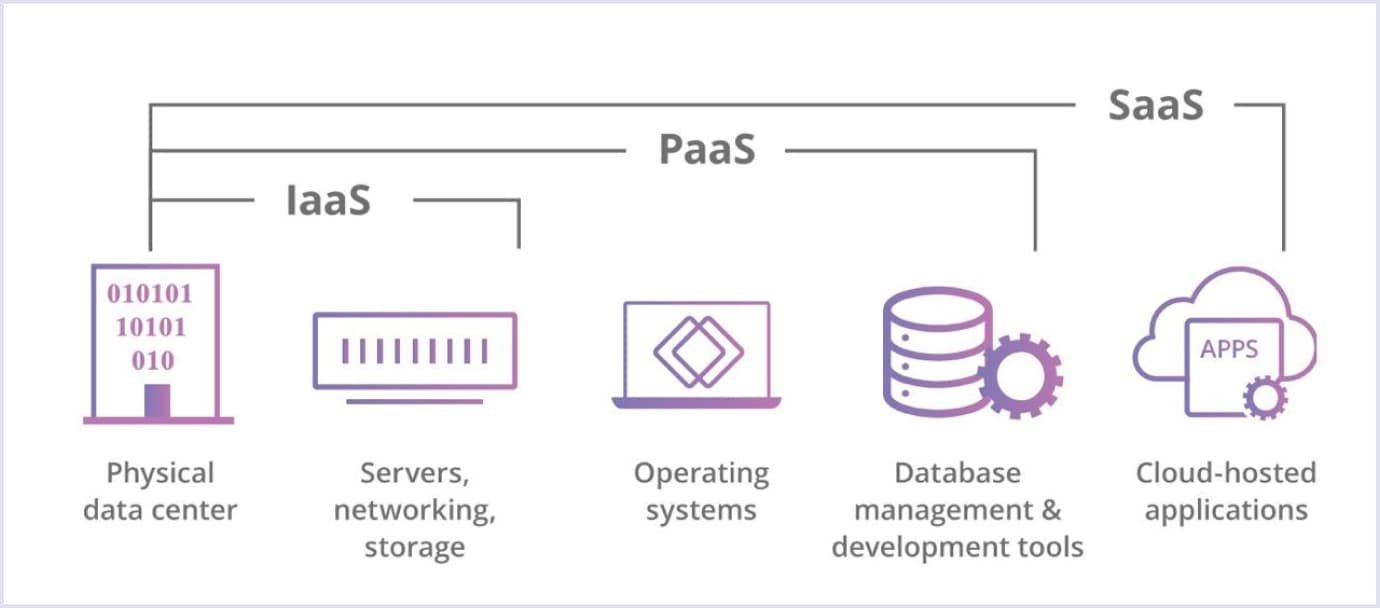
Let’s check basics of IaaS vs PaaS battle in more detail:
What is IaaS?
Infrastructure as a service (IaaS) forms the foundational layer of cloud computing, offering the fundamental building blocks of IT infrastructure, such as virtual machines, storage, and networking. IaaS gives users more control and flexibility over their infrastructure, allowing them to manage and customize their virtualized resources according to specific requirements.
In general, IaaS is a virtual data center, empowering organizations to scale resources up or down based on demand without the limitation of physical hardware maintenance.
The main characteristics of IaaS cloud service include the following:
- The service provides development resources;
- You pay as much as you use;
- Services are scaled easily;
- One piece of hardware is available for many users;
- IaaS providers have complete control over the computing infrastructure;
- Ensures dynamics and flexibility for developers.
The prominent IaaS solutions are as follows:
- Amazon Web Services (AWS);
- Google Compute Engine (GCE);
- Digital Ocean;
- Cisco Metacloud.
What is PaaS?
Platform as a service (PaaS) includes the infrastructure, tools, and services to facilitate application development and deployment. Developers leveraging PaaS can focus on coding and application functionality as the underlying complexities of infrastructure management are abstracted away.
The main characteristics of PaaS include the following:
- Based on virtualization technology. So, you can scale PaaS resources as your business changes;
- Offers services to develop, test, and deploy solutions;
- Can be accessed via the same development environment;
- Includes operating systems, databases and web services.
The most popular examples of PaaS include the following:
- Microsoft Azure;
- Google App Engine;
- AWS Elastic Beanstalk;
- Red Hat OpenShift;
- Heroku.
IaaS vs PaaS vs SaaS comparison
Our team prepared an extended comparison table that offers a more detailed insight into the distinctive characteristics of IaaS, PaaS, and SaaS. This table aids organizations in making informed decisions based on their specific requirements and goals.
| Aspect | IaaS | PaaS | SaaS |
| Definition | Provides virtualized computing resources over the Internet, offering fundamental infrastructure elements. | Offers a comprehensive platform (including infrastructure, tools, and services) to facilitate application development and deployment. | Delivers software applications over the Internet, with the entire software stack managed by a third-party provider. |
| Control and customization | Maximum control and customization over infrastructure elements, allowing users to configure virtualized resources. | Provides a middle ground, abstracting away infrastructure details while allowing customization at the application level. | Minimal control; users can only configure settings within the software application, lacking control over the underlying infrastructure. |
| Responsibility and management | Users are responsible for managing applications, data, runtime, middleware, and operating systems. | Management responsibilities are shared, with the cloud provider handling infrastructure, while users focus on application development and deployment. | Cloud providers manage all aspects, including infrastructure, middleware, application, and data. Users are responsible only for using the software. |
| Scalability | Offers scalability by allowing users to adjust resources based on demand, suitable for varying workloads. | Facilitates scalability, particularly focusing on the application layer, abstracting infrastructure scalability details. | Provides inherent scalability, as the software is hosted and managed by the provider, ensuring optimal performance for end-users. |
| Development focus | Infrastructure management and customization are key areas of focus, suitable for projects with specific infrastructure requirements. | Accelerates development by abstracting away infrastructure complexities, allowing developers to concentrate on coding and functionality. | Primarily focuses on end-user experience and software functionality, with minimal involvement in infrastructure or development details. |
| Use cases | Ideal for scenarios where organizations require full control over infrastructure elements or have specific hardware and software requirements. | Suited for development teams aiming to streamline the application lifecycle, collaborate more effectively, and reduce time spent on operational tasks. | Best for organizations seeking ready-to-use software applications without the need for infrastructure management or customization. |
Thus, we have discussed the significant difference between IaaS, PaaS, and SaaS cloud models. If you want to go deeper into this topic, we have also prepared an article where we consider specific examples of IaaS, PaaS, SaaS.
How to build a SaaS product from scratch
At Codica, after more than nine years, we developed a stable mechanism of delivering exceptional-quality products. Thus, according to the flow we cultivated, we divide all development services into sizeable milestones. Each milestone represents a specific step on the development curve, with a particular focus and task.
Step 1: Research and discovery
Each extensive development process begins with thorough research and product discovery. It is a service Codica provides that encompasses all essential milestones of the development. It greatly relies on thorough cooperation with the founder.
Throughout the discovery, we collaborate with the founder, evaluate their ideas, and involve them into all the processes. For instance, we conduct thorough research on the SaaS idea, choose a tech stack, and determine the product's requirements. Here are the most crucial parts of product discovery.
Market analysis
First, we refine your idea and research it to determine whether it is viable enough to build a SaaS product based on it. Our team analyzes the market segment you want to break into. To understand the situation in the market you are planning to enter, we analyze the future product based on key questions:
- Who is the target customer?
- What are their main pain points?
- Who are the potential competitors?
- What essential/unique features do they have?
- What business models do they adopt?
The market analysis will help you explore business opportunities and find ones preferable for you. Choosing appropriate strategies for SaaS product development services and understanding how to build a cloud solution is crucial.
Let’s take Slack as an example. It is a successful SaaS-based communication platform that generated over $533 million in revenue as of 2023 and has millions of active users.

Stewart Butterfield, a founder of Slack, believes that when developing a go-to-market strategy, it is essential to create a cloud product that differs from competitors. This product also should play a significant role in your target audience's lives.
Stewart Butterfield highlighted three things the company has improved: search, sync, and ease of file sharing. With three points, Slack has become a leader among similar companies.
Thus, you have every chance of success by focusing on what is valuable to your audience. A product discovery process is a crucial step if you’re developing a product with us.
Business plan
Another important part of product discovery is a business plan, which is a roadmap for your software-as-a-service product. Let’s describe the crucial points you should mention in your plan to know exactly how to build a SaaS product.
1. How can you distinguish your product from the others?
Your company’s identity, product name, the value you want to share with your customers. Try to describe it in one brief sentence and make it catchy.
2. What are the main pain points of your potential customers, and how will your project solve them?
Determine the problems you want to solve with your product.
3.How can you reach your target audience?
Choose a marketing strategy for your promotion. Content marketing, social media, advertising, partnerships, etc. – there are plenty of options here.
4. How will you make money with your SaaS product?
Define your monetization strategy. Consider different subscription plans, advanced support, and some sorts of upgrades. You can use freemium, flat-rate, usage-based, tiered, or per-feature pricing.
5. Where do you want to get financial coverage, and how do you want to spend it?
Estimate your primary expenses, dividing them into different areas. Also, identify the funding sources for your enterprise. You can opt for your own budget, investments, or crowdfunding.
6. What are the goals to be achieved to realize your vision?
And finally, create a list of fundamental goals for the first few months of your custom enterprise software solution.
The plan will most likely be subject to change. But it is a prerequisite for making up your mind about how to build a SaaS product successfully. Once the business plan is established, it can also be enhanced further. For instance, in collaboration with the founder, we can choose crucial metrics to track and set standards for them.
Technical stack
The technology stack is a list of the programming languages, frameworks, and tools used in software development. Nowadays, technologies provide a huge variety of options to choose from.
Let’s take a look at the technologies we prefer at Codica:
Frontend:
- JavaScript;
- TypeScript;
- React;
- Redux;
- Next.js;
- HTML5;
- CSS3;
- Gatsby.
Backend:
- Ruby on Rails;
- Ruby;
- Node.js;
- Strapi.
Database:
- PostgreSQL;
- MySQL;
- MongoDB;
- Redis;
- Firebase;
- ElasticSearch.
SaaS hosting providers:
- AWS;
- Digital Ocean;
- Heroku.
DevOps:
- Linux;
- Ansible;
- Docker;
- Gitlab CI;
- Terraform.
Integrations:
- Stripe;
- Google Analytics;
- Paypal;
- Mollie;
- Hotjar;
- Sentry;
- MailChimp;
- HubSpot;
- Uptime Robot;
- Skylight.

Step 2: UI/UX design
Right after completing an extensive product discovery, UI/UX design services come into play. With all the information on the future SaaS product needed, designers put lots of effort into making your product visually appealing and engaging to users.
Prototyping
It is the initial step in our development process, allowing us to focus on the project's architecture without the distraction of color and font. The prototypes, depicted in a subtle gray-blue palette, serve as a canvas to meticulously plan the logic of future user roles, creating a seamless user journey. Here’s a quick example of the prototype our team designed.

Once these prototypes are transformed into clickable versions, we present them to the client for comprehensive evaluation.
Visualization
Moving on to the visualization phase, we collect references to guide the design process. We finalize the project's style, including fonts and color schemes. This critical phase involves presenting multiple design options for client approval, ensuring a shared vision for the project.
Design
Lastly, in the design phase, we utilize the approved visual elements to create a comprehensive guideline. This document outlines numerous details, such as element sizes and colors, fonts, imagery, and other essential design elements.
As we delve further into this article, we will unveil more details about the MVP design.
Step 3: SaaS product MVP development
What do you need to launch a successful SaaS application and validate the value proposition? We have no doubt about it – creating an MVP (minimum viable product) is an advisable stage of your SaaS product development.
Building SaaS products requires lots of time and investments. To save them, MVP is an excellent choice. An MVP is not a fully-fledged product, but it has enough features to attract early users and validate an idea. MVP is ready to enter the market and can further be scaled and amended. Moreover, it is an excellent business decision for a SaaS product as it allows us to test the idea before creating a full product.
Although it is not an end-product, it solves your customers’ critical problem. An MVP must appeal to your target audience and make people love your product. The primary purposes of launching an MVP prior to developing a fully functional SaaS product are:
- Collect and analyze feedback. It provides valuable information on usability and user experience. What did users like and did not? What functionality should be added/modified/removed?
- Test the waters. It allows you to check whether your application will suit the rapidly growing SaaS market. Also, you will know whether customers are willing to buy your services. Will there be enough demand for your application?
- Try different concepts. MVP gives the possibility to measure the effectiveness of business hypotheses. Focus on the whole impact of your SaaS application, not only on its features.
At Codica, we recommend creating an MVP in order to quickly collect feedback, check the technical implementation of the idea, and demonstrate it to investors or clients. For example, we developed an MVP for accommodation search for expats. The project idea was to facilitate the relocation process to Australia for people who found employment.
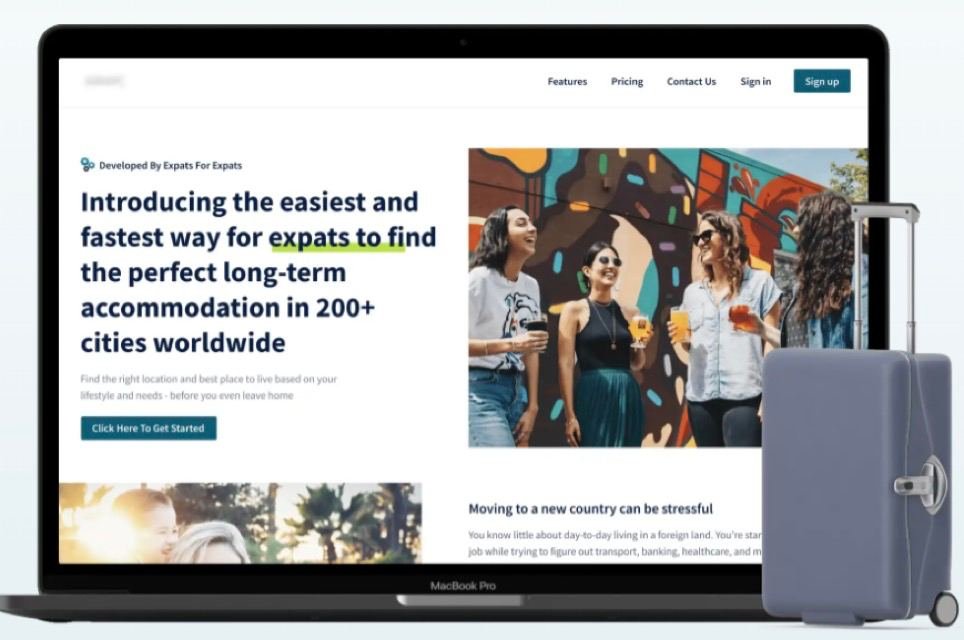
As a result, our client successfully tested the cloud product in practice and presented it to investors. Consequently, this healthy approach proved to be beneficial as our client successfully raised funds for further development and continued to actively scale the platform.
Step 4: Quality assurance and optimization
Developing and delivering a superior product is not an easy task. Thus, quality assurance (QA) is the crucial step to make this process easier. The development process is closely intertwined with quality assurance services, where testing plays a pivotal role in ensuring that the product aligns with your business requirements and industry standards. A refined and polished product not only increases user engagement but also enhances customer retention.
Based on our experience, a deep understanding of product requirements facilitates seamless testing. The QA team, equipped with appropriate testing documentation, conducts both manual and automated tests. At Codica, our testing strategy focuses on verifying compliance with product specifications, allowing our quality assurance specialists to conduct a range of tests tailored to the specifics of SaaS applications.
Speaking of the testing processes, there are various tools QA specialists use to ensure the product is stable and performant. For instance, they employ different types of testing to see how each functioning part of the product works.

- Security testing. Validates the secure storage of sensitive data and ensures the resilience of the product against common security attacks.
- Compatibility testing. Checks the app's compatibility with various browsers, allowing you to choose the most popular ones for your customers.
- Functional testing. Evaluates the features of the solution and examines possible configurations and customizations within the SaaS app.
- External API testing. Validates the seamless functioning of SaaS app APIs (application programming interfaces) with software and third-party applications, ensuring the correct operation of the APIs.
- Backup and recovery testing. Verifies the app's capability to revert to the previous version and recover data in the event of a fault.
- Performance testing. Assesses how well the app performs under expected stress and loads, ensuring it supports the anticipated number of simultaneous users, manages memory usage, and maintains optimal response times.
- Usability testing. Examines the convenience of content layout, evaluates deliverables from UX/UI design services, and assesses the user-friendliness of the application.
- Regression testing. Ensures the continued correctness of the SaaS app after software updates and changes, contributing to the stability and uninterrupted functionality of the SaaS solution.
Clearly, there are more testing types, and such a comprehensive testing approach validates the SaaS application's functionality and performance and fortifies its security. It improves usability and resilience to changes, providing a robust and reliable end product.
Step 5: Deployment
Considering that SaaS apps are stored on the web and work absolutely online, deployment is an important stage of the entire product development process. In other words, deployment is the process of making your SaaS product available to the public. The entire product has to be carefully tested and polished to perfection to not spoil the initial impression for users.
For this to happen, though, DevOps specialists’ work proves to be irreplaceable. With our reliable DevOps services, the deployment process works on automation, and specialists ensure it works as intended. Each version of the app receives a number and after the initial release, automation allows developers to release new smaller updates without the need of shutting down the entire app. This way, we can regularly implement new features, improve performance, and fix any bugs and issues.
Lastly, another important aspect you need to know about is a hosting provider for your SaaS app. Considering that users don’t need to download it, SaaS apps are stored on servers and are accessed through the web. Hence, SaaS provider choice is crucial for making your app accessible and secure.
Step 6: Post-release monitoring and maintenance
After we create a SaaS product, the work is far from over. Technologies always evolve while, for example, UI/UX design trends regularly change too. Thus, every SaaS app needs updates every now and then. Accordingly, at Codica, we always offer our clients to support the app even after its release. This way, we can bring changes, add updates, and new content.
Unlocking the success of your SaaS product
After the initial release, we evaluate the metrics the SaaS product generates. Then, we learn from them and update the app accordingly. In layman’s terms, it is called a feedback loop and consists of three main actions, namely, build, measure, and learn. After all, it is a great technique that helps to deliver superior quality solutions.
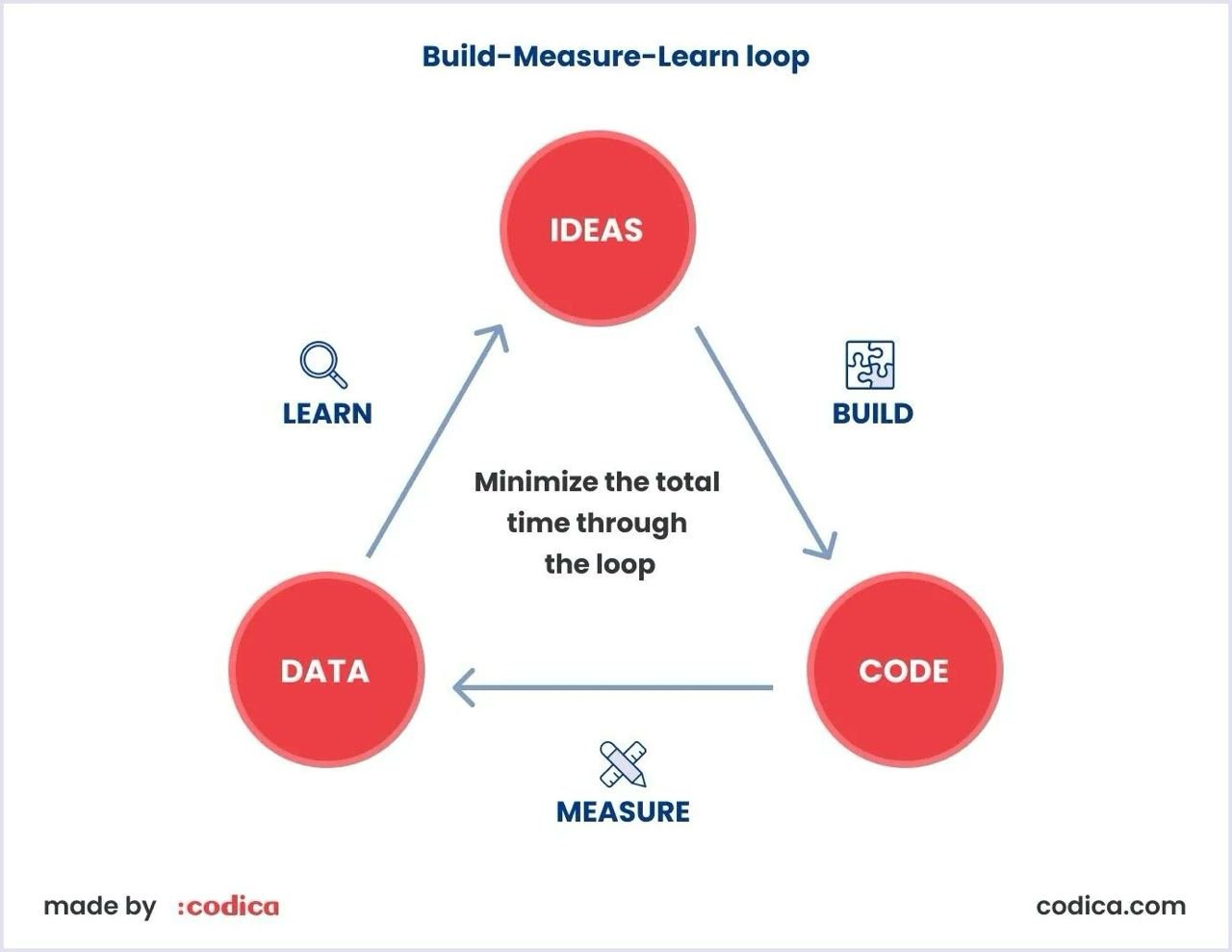
In the context of SaaS, several key metrics are commonly used to evaluate the performance and health of a SaaS business. Here's a brief overview of each:
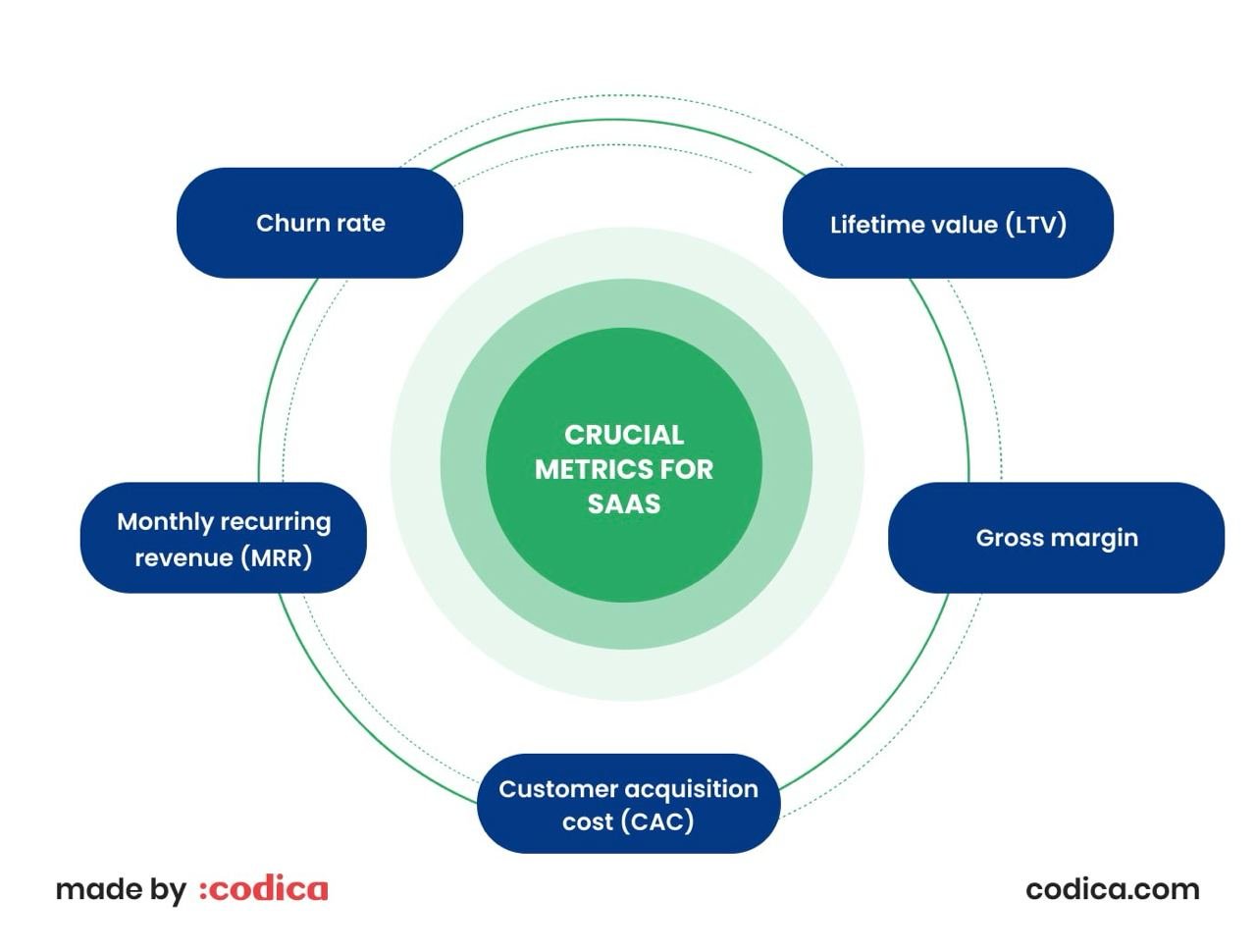
Lifetime value (LTV)
In fact, LTV represents the total revenue a business expects to earn from a customer throughout its entire relationship. It helps businesses understand the long-term value of acquiring a customer.
Gross margin
It measures the profitability of a SaaS business by subtracting the cost of goods sold (COGS) from the total revenue. It provides insights into the efficiency of delivering the product or service.
Customer acquisition cost (CAC)
So, CAC is the cost associated with acquiring a new customer. It includes all expenses related to marketing, sales, and any other activities aimed at gaining new customers.
Monthly recurring revenue (MRR)
It represents the predictable and recurring revenue generated from subscription-based services on a monthly basis. It is a fundamental metric for subscription businesses.
Churn rate
Churn, also known as customer attrition or customer churn rate, measures the percentage of customers who stop using a service within a given time period.
Team composition for SaaS development
To develop a superior SaaS product, a professional and coherent team is a must. However, the team composition for SaaS development can vary based on the size of the project, its complexity, and specific requirements. Thus, the exact composition is often defined during the product discovery mentioned previously.
Although SaaS development is individual, the basic team should normally consist of the following specialists:
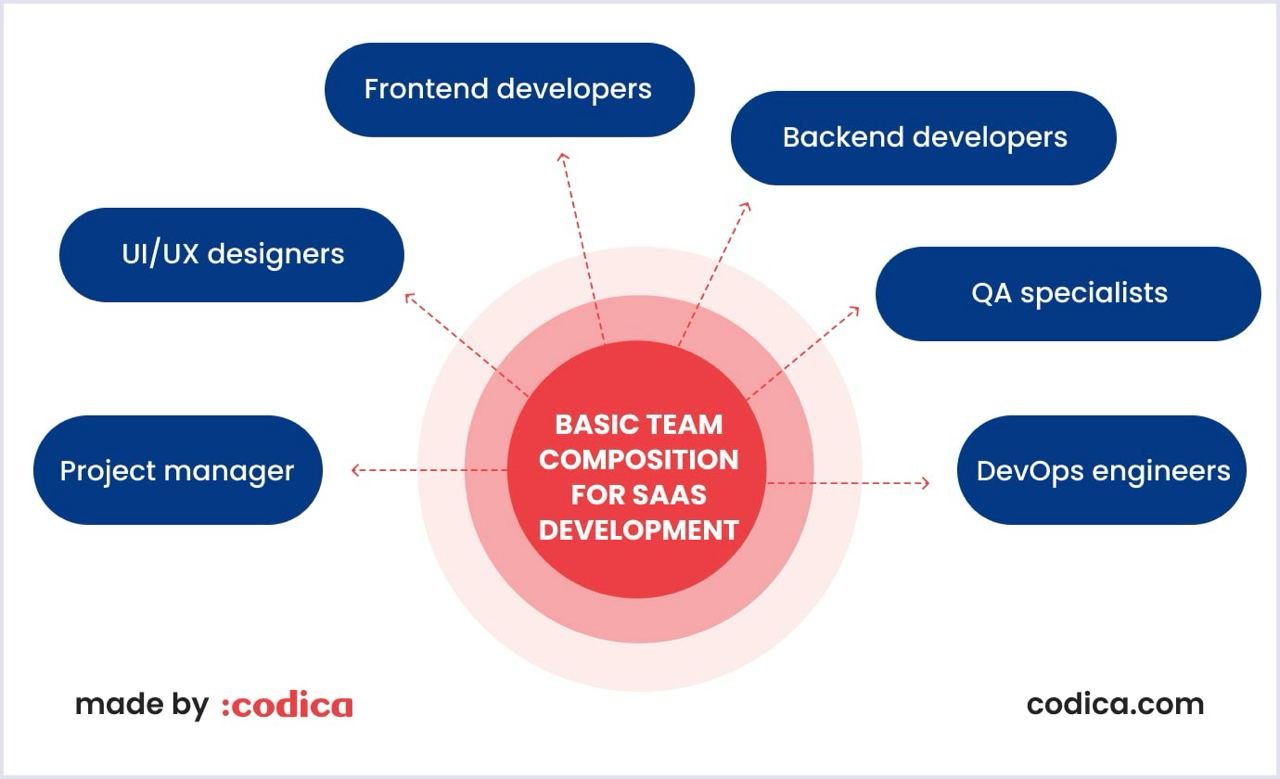
Project manager
During the entire development process, project managers guide and manage all activities of the team. For instance, project managers create and maintain project deadlines and ensure the project is delivered on time and within budget. Moreover, they are usually responsible for active communication with clients.
UI/UX designers
These specialists do not only design the pages of the product. They choose color schemes, fonts, and create wireframes, mockups, and prototypes. Besides, emphasis on UX brings much-desired usage comfort and convenience. As a result, a combination of UI and UX brings the SaaS product as close to the product concept as possible.
Frontend and backend developers
In layman’s terms, frontend developers focus on the user interface and user experience. They implement features according to the technical requirements defined during the product discovery and prove them valuable during the MVP stage. They enliven the visual concepts designers have created while enriching the product with features. Thus, frontend developers work with the functionality of the solution, implement APIs, third-party services, and much more.
Backend developers, in turn, focus on the backbone of the solution, namely its connectivity to the servers and databases. They handle server-side logic and database interactions while ensuring the product is performant and stable. Moreover, as SaaS products work on the web almost exclusively, backend developers’ efforts play a pivotal role in maintaining and developing the app.
Quality assurance engineers
By running different types of tests, these specialists ensure the product works as intended. They test the application for bugs, usability, and performance issues by developing and executing test plans. Additionally, their work is done regularly to ensure stability at all stages of development.
DevOps engineers
Apart from the development itself, the working environment requires maintenance, which DevOps specialists provide. They set up and maintain the development and production environments and automate deployment processes. Additionally, they emphasize the security aspect of the development, implement security best practices to protect user data, and address security risks throughout the process.
The specific roles and their emphasis can vary based on the development methodology (e.g., Agile, Scrum) and the size and nature of the SaaS project. Effective communication and collaboration among team members are crucial for successful SaaS development.
SaaS security
It is well-known that SaaS has become a cornerstone for businesses seeking scalable and flexible solutions. To safeguard your digital assets and sensitive data, it is imperative to develop a detailed SaaS security checklist that addresses critical protection factors. Let's delve into some crucial strategies to fortify your SaaS environment.
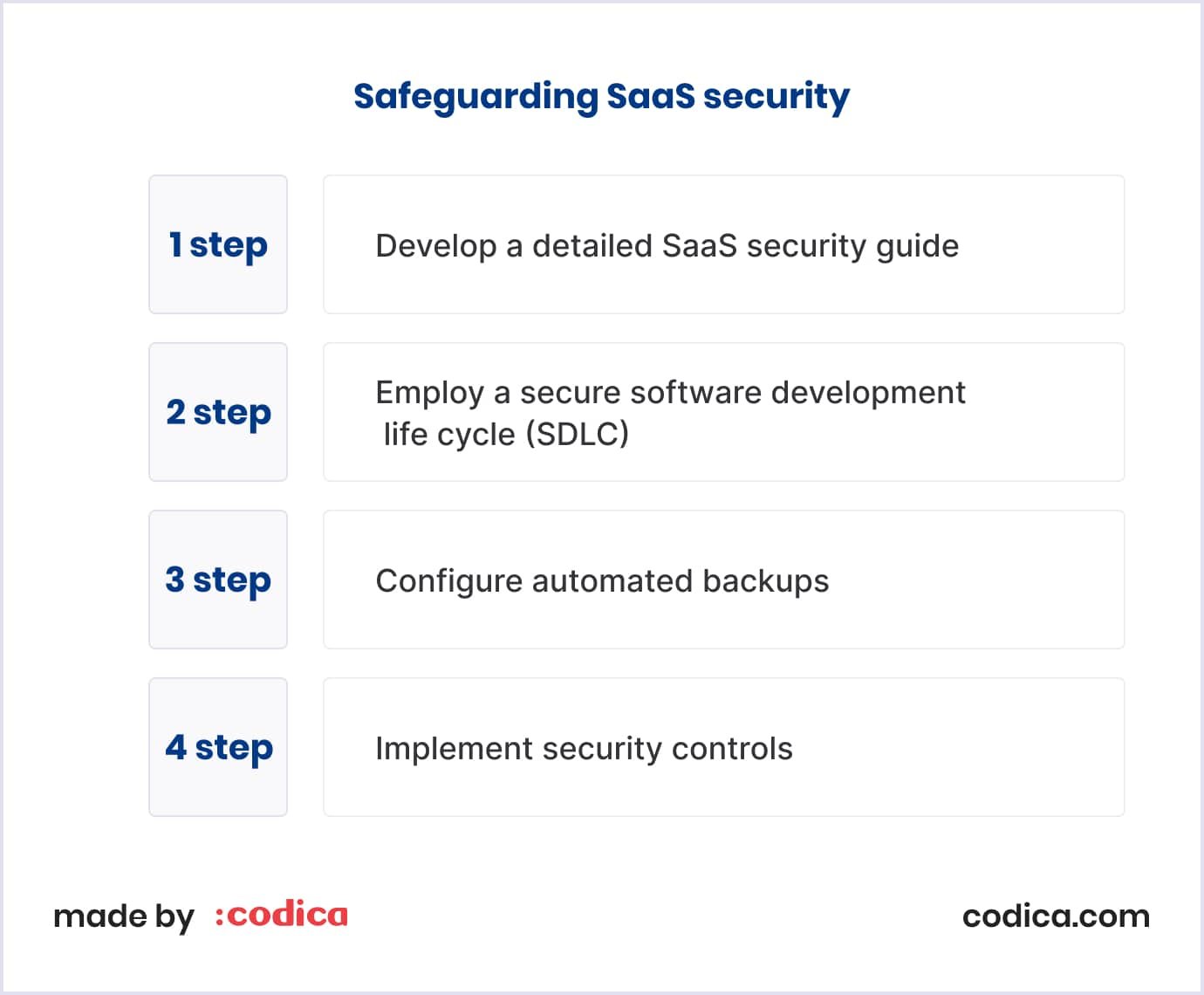
1. Develop a detailed SaaS security guide
Begin by conducting a comprehensive risk assessment to identify potential vulnerabilities. Tailor your guide to encompass technical aspects and user education, emphasizing the importance of password hygiene, multi-factor authentication (MFA), and the careful handling of sensitive information. Regularly update and communicate the guide to ensure your organization's security approach is proactive.
2. Employ a secure software development life cycle (SDLC)
Security should be integral to the software development life cycle from inception to deployment. Entrenching security measures into every phase ensures that vulnerabilities are identified and mitigated early.
Promote secure coding practices, conduct regular code reviews, and integrate automated security testing tools. Adopting a security-first approach in your SDLC will fortify your SaaS applications against potential threats, providing a solid foundation for a secure user experience.
3. Configure automated backups
Of course, data loss can be catastrophic for any business. Implementing automated backups is a fundamental step in securing your SaaS environment. Regularly back up critical data and ensure the process is automated to eliminate the risk of human error.
Also, consider redundant storage options and verify the integrity of backups periodically. In a security incident or data corruption, automated backups will be your lifeline, enabling swift recovery without compromising business continuity.
4. Implement security controls
You can employ encryption protocols to protect data both in transit and at rest. Implement access controls, defining roles and permissions based on the principle of least privilege.
Moreover, regularly audit user access and promptly revoke privileges for employees who no longer require them. Monitor user activity and network traffic to detect and respond swiftly to abnormal behavior. Additionally, keep software and systems up-to-date with the latest security patches to mitigate known vulnerabilities.
Thus, safeguarding your SaaS environment demands a holistic approach containing user education, development practices, data protection, and continuous monitoring. By employing comprehensive SaaS security standards, your company can confidently guide the digital landscape, ensuring your data's confidentiality and integrity.
SaaS design
A well-designed SaaS application captivates users and enhances their productivity and satisfaction. Let's explore the key elements and considerations of SaaS product design.
The role of design in a SaaS product
SaaS application design is the curator of user experiences, the architect of seamless user interfaces (UI), and the compass guiding users through the digital landscape.
Below are the leading indicators of the importance of SaaS design.
- User-centric approach. Understand your target audience, their pain points, and the tasks they aim to accomplish using your software. Incorporate user feedback throughout the design process to create an intuitive interface that aligns seamlessly with user needs.
- Speed and performance. Users are more likely to engage with an application that responds promptly to their commands. Regularly conduct performance tests to identify and address any bottlenecks.
- Responsive design. It guarantees a consistent and enjoyable user experience, whether your users are accessing the application on a desktop, tablet, or mobile device.
- Consistent branding. It builds trust and helps users associate your product with a familiar and reliable experience. Use a harmonious color scheme, typography, and imagery to reinforce your brand.
- Data visualization. Effectively visualize data to make it understandable and actionable for users. Incorporate charts, graphs, and interactive elements to present information in a visually appealing and digestible format.

Examples of good SaaS website designs
Exemplary SaaS website designs showcase aesthetic finesse and embody intuitive functionality principles. So, let's discover a few standout examples together!
1. Easy sign-in and sign-up
Signing up signifies a user's commitment to your software over other alternatives. Therefore, the registration process should prioritize simplicity. Gather only essential information, such as the user's name and email address. While additional information may be sought, it's advisable to keep the process concise and straightforward.
For instance, the following sign-up design for HelpScout is simple and user-friendly.

2. SaaS personalization
So, personalization involves tailoring product experiences to align with the specific features users utilize. To achieve this, collecting customer data becomes instrumental. The primary objective of personalization is to deliver an optimal user experience. Here are some illustrative examples demonstrating how you can augment collaboration with your high-quality SaaS.
A notable instance of interface personalization at the UI level is observed in ClickUp. Here, customers can add or remove features from the SaaS UI based on their requirements.

So, SaaS application design requires a holistic approach, prioritizing user needs, intuitive navigation, and a cohesive brand identity. By incorporating these principles and drawing inspiration from successful examples, you can create a SaaS application that meets and exceeds user expectations.
Biggest problems for SaaS companies
In fact, companies often face many SaaS development challenges that can make or break their success. Some hurdles stand out and affect the growth of SaaS companies.
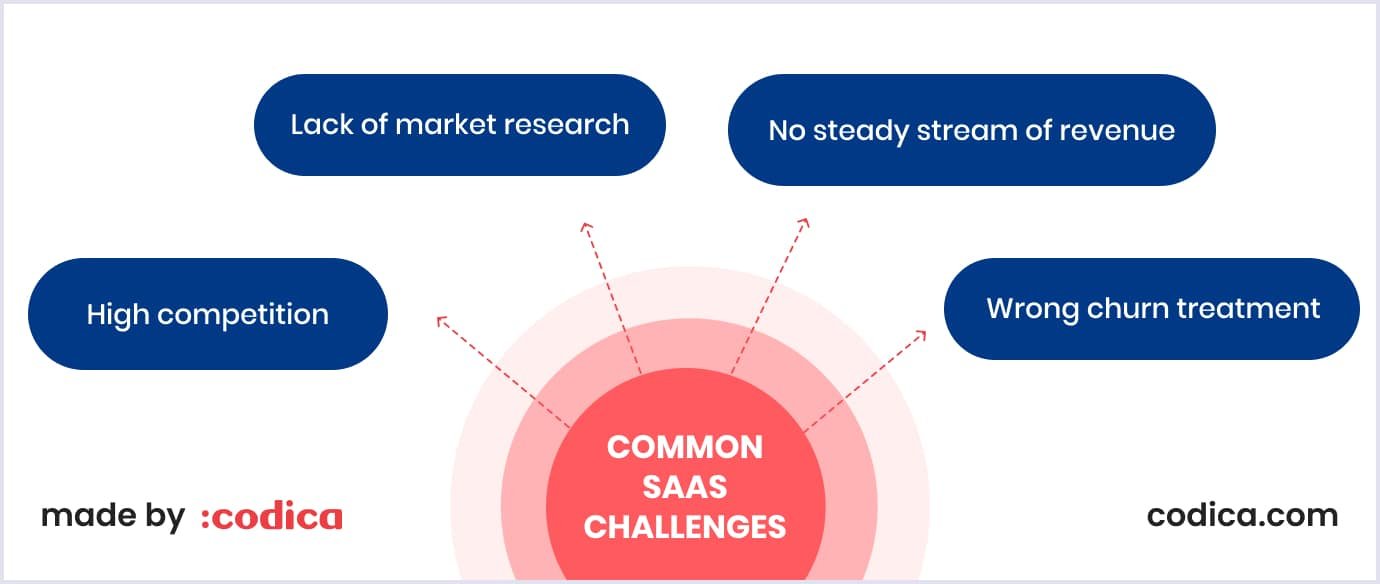
Lack of market research
Understanding the target audience, competitors, and market trends is crucial in a landscape where user needs evolve rapidly. Failure to invest in thorough market research may result in developing solutions that miss the mark, leading to a lack of user adoption and market traction.
Successful SaaS companies prioritize a deep understanding of customer pain points, industry trends, and emerging technologies. They create products aligned with market demands and develop strategies that stand resilient in the face of industry shifts.
At Codica, we assist our clients in identifying potential competitors, creating a viable monetization model, defining the target audience, and assessing profitability terms.
High competition
According to a Statista report, the global SaaS market is anticipated to keep growing. By 2023, the SaaS market is projected to be valued at around 232 billion U.S. dollars in 2024. SaaS applications operate in the cloud and are typically accessible through desktops, mobile apps, and web interfaces.

To overcome SaaS challenges, companies must differentiate themselves through unique value propositions, user experience, and customer service. Building a solid brand presence, improving niche markets, and continuously innovating is crucial for creating a distinctive space amidst competitors.
No steady stream of revenue
One of the fundamental SaaS challenges for companies lies in achieving a reliable and steady revenue stream. While offering recurring income, the subscription-based model demands a delicate balance between acquiring new customers and retaining existing ones. Changes in customer acquisition and retention rates can lead to revenue instability, hindering long-term sustainability.
To address this challenge, SaaS companies must invest in customer success initiatives, providing continuous value to retain subscribers. Diversifying revenue streams, exploring strategic partnerships, and implementing flexible pricing models can also contribute to building a resilient financial foundation.
Wrong churn treatment
Churn (the percentage of customers who stopped using your services in a specific time period) can be a silent killer for SaaS companies. The challenge lies not only in reducing churn but also in addressing it effectively when it occurs. Misunderstanding the reasons behind customer departures can lead to misguided solutions and extend the problem.
For example, successful SaaS companies approach churn with a holistic perspective, delving into customer feedback, analyzing usage patterns, and understanding the root causes. By adopting proactive churn prevention strategies (personalized onboarding, continuous product improvements, and attentive customer support), SaaS companies can reduce the impact of churn and foster long-term customer relationships.
Thus, companies should always be ready for SaaS development challenges to avoid business problems. With strategic foresight and adaptability, SaaS enterprises can weather the storms and thrive in the dynamic digital ecosystem.
Cost to build a SaaS product
When it comes to creating complex SaaS products, pricing is one vague point. The variety of functionality and forms modern SaaS apps have is spectacular, and it’s crucial to understand that everything has a price. Thus, the cost of building a SaaS product depends on its complexity and the hourly rates of the professionals involved in its development.
The more ambitious the project, the more expensive it is going to be. Thus, full-fledged products require lots of resources. Hence, the price is higher, varying from $15,000 and more.
Hourly rates based on the location are another important aspect worth mentioning. For instance, in software development, hourly rates for professionals vary from $30 to $70 based on their skill level, location, and other variables.
However, to put you into context more, we can estimate approximate prices for building a SaaS product MVP. In this exemplary table, we use a set rate of $50 per hour. We list common functionality many SaaS apps have, yet the cost varies in each particular case, and your technical partner will give you a precise quote.
| SaaS product development price | ||
| Features | Time, hours | Cost, $50/hour |
| Design | ||
| UX Development | 64 | $3,200 |
| UI Development | 96 | $4,800 |
| Architecture | ||
| Project setup | 24 | $1,200 |
| DB structure | 32 | $1,600 |
| Integrations | ||
| Payment (Stripe or PayPal) | 64 | $3,200 |
| Main functionality | ||
| Authorization and security | 64 | $3,200 |
| User profiles | 40 | $2,000 |
| Homepage | 56 | $2,800 |
| Search and filters | 72 | $3,600 |
| Reviews & Ratings | 48 | $2,400 |
| Payout | 40 | $2,000 |
| Notifications | 48 | $2,400 |
| Messenger | 64 | $3,200 |
| Managing listings | 64 | $3,200 |
| Booking system | 64 | $3,200 |
| Property page | 72 | $3,600 |
| Admin panel | 96 | $4,800 |
| User panel | 84 | $4,200 |
| Non development activity | ||
| Project management | 96 | $4,800 |
| Quality assurance | 104 | $5,200 |
| Code review | 48 | $2,400 |
| Total | 1340 | $67,000 |
Codica's expertise in building SaaS applications
The Codica team specializes in delivering SaaS development services designed to elevate your business above competitors by offering a distinctive, secure, and scalable solution. Whether you seek to create a new cloud-based application or manage an existing product, we are eager to share our expertise and passion for cloud solutions, addressing any SaaS-related challenge you may encounter.
Throughout the years of delivering exceptional products, we haven’t simply created SaaS solutions. Instead, we mastered building a wide variety of products tailored to different industries. As of now, we create CRM, ERP, CMS systems, and more, all of which greatly simplify management, streamline working processes, and enhance the user experience.
In addition, we have deep experience delivering SaaS products across multiple industries. Here are several examples.
Online domain trading
The Codica team played a critical role in redesigning existing functionality and introducing new, impactful features to the Dan platform. This is a reliable domain sale website.
Our efforts have hardened its reputation for user-friendly functionality. The addition of new features, options, filters, pop-ups, categories, columns, toolbar enhancements, a price calculator, infinite scroll, and more has ensured swift, seamless, and convenient navigation throughout the platform.
The video below provides an in-depth explanation of the platform's enhanced functionality and operations.
Bakery
At Codica, our experts created an intuitive and secure SaaS platform for bakery business - CakerHQ. Working on this platform, not only did we deliver a performant product, but also made it look neat and easy to use. As a result, CakerHQ brings just the right vibe to people who fuel parties with their cakes and to customers who seek delicious masterpieces for their celebrations.
Here’s an overview of the platform highlighting how it works and looks.
In summary, Codica's expertise in custom SaaS solutions spans various industries, and our agile methodology ensures the effective development of quality SaaS applications. As a trusted SaaS development company, we are committed to providing profitable and efficient SaaS products for businesses of all sizes. If you have a groundbreaking SaaS idea, we are here to bring it to life.
Conclusion
The SaaS model, without a doubt, has produced a great variety of business opportunities. To take the best from it, follow our expert step-by-step guide on how to build a SaaS product. And, of course, customize your SaaS product to stand out in the best possible way.
For now, our expert team sincerely hopes this article sheds more than enough light on all the intricacies of SaaS development. Still, if challenges persist, the Codica team can take care of your SaaS development needs and help to realize your vision. Browse through our portfolio, or just contact us to discuss your business idea.


